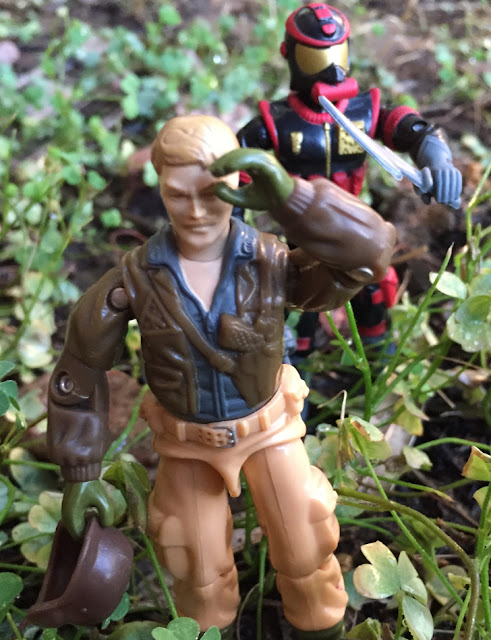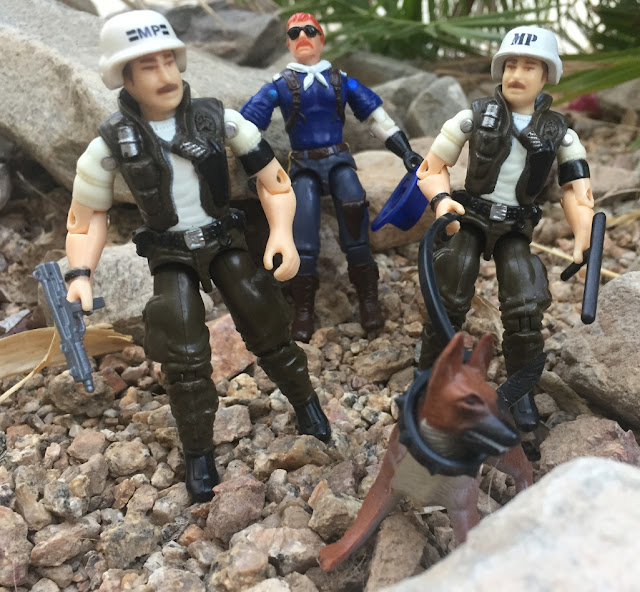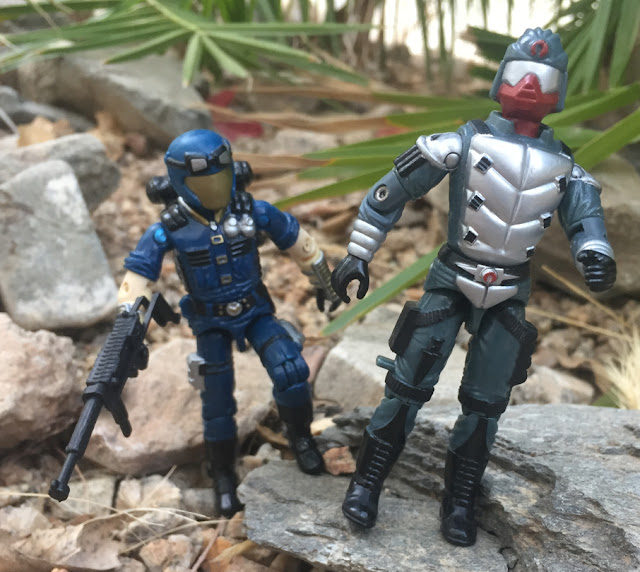As I hunted down the last bastions of vintage G.I. Joe at retail in the mid 1990's, I used both cardbacks and catalog inserts to tell me which figures I should expect to find. What these reference materials didn't tell me, though, was the multitude of repaints that also existed on figures. Some differences, like the 1993 blue and orange vs. the 1994 black and grey Snow Storm were obvious. Others, like the slightly fewer painted black details on the 1994 Shipwreck were harder to spot. It was not until online references really got completed in the late 1990's that I was fully able to understand the vast amount of variants and paint differences that exist among figures produced between 1992 and 1994. Some of these repaints are good, some are bad and most are just...there. That is the case of this 1994 Stalker. My experience with the figure from retail was the black and green version that's one of the best figures from the 1990's. But, the other version...this original release with neon painted highlights also exists. With a better Stalker figure available, this neon version is easy to skip. But, it's a quintessentially 1990's toy and that's what makes it fun.
It's no secret that I love this design for Stalker. He was among the first figures I ever profiled on the site back in 2000. And, I took another pass at him in early 2013. Both of those times, though, I focused on the black and green figure. The base colors are a perfect match for vintage Night Force and, when not overdone, make for a good figure. I don't want every figure in this color scheme. But, getting one of the four or five most important characters in the Joe mythos in that scheme was important. In black, Stalker can better match up with vintage Snake Eyes figures and even meshes well with other figures from 1985 or 1986. That's a rarity for figures sculpted in the line's final years. But, it shows how good work that's true to a character can transcend year.
To me, this Stalker perfectly captures the essence of the character as he evolved in the comic. Here you have Stalker as a powerful fighter. But, you also see him more out of his Green Beret specialty and more of a urban, covert operative. This Stalker would take on missions like Borovia and live to return. He could also fight Cobra in the streets of the U.S. while better blending into the background. In short, he seems a more commando version of Stalker. And, for a guy who palled around with Snake Eyes, Stormshadow and Scarlett, that seems like a role to which he's be best suited.
I found the 1994 Stalker figure at retail. Mine, though, did not have the neon highlights. But, quickly, this figure became one of my favorites. The excellent weapons and sleek design made him on the best figures I found at retail in the mid 1990's. And, 25 years later, the figure still remains a popular choice for my photos and dios. Part of that is holdover from him being one of the top two or three figures I had available to me. But, another part of it is that the figure is just solid and works well in a variety of scenarios. You know the figure is Stalker, too, and that's a huge help when working with such an iconic character.
In 1994, Hasbro started to experiment with the Joe figure design. As such, newly sculpted figures like this Stalker have more heft to them. It was an attempt to slowly upsize the figures to better stand tall against the larger figures that were dominating retail of the mid 1990's. The most noticeable aspect of this figure is his large torso. Seeing that Stalker is wearing a tactical vest helps to explain this away. But, the real issue is that Stalker's arms are lower on his shoulders. Big shoulders started appearing in 1994 and would have gone to even more extremes in 1995. When posed with 1993 and 1992 figures, this Stalker's proportions are less obvious. But, when stood next to 1985 or 1987 figures, the design changes are notable. The Joe line always evolved. From swivel arms to ball heads, Hasbro was contantly improving the figures. By the 1990's, though, the "improvements" were no longer about leading the market and making the best action figure available. Other properties had surpassed Joe as kind of the retail toy stores. And, Hasbro spent effort trying to keep up with other companies while still trying to maintain some semblance of connection to the 12 years of toys that preceded the 1994 run. The result is that this figure doesn't work all that well with many vehicles from the 1980's. And, for many collectors who grew up in Joe's early years, the proportions seem off enough to dismiss these late figures. When you understand the evolution of the line, though, that is forgivable. And, a good figure is a good figure. This Stalker delivers on that.
In the Star Wars world, the right Country of Origin (COO) stamp on a specific figure can be the difference between a $10 common and a $100+ rarity. In the Joe world, there are COO variants, too. Generally, collectors don't much care. This is due to the size of the vintage Joe line, the obscurity of the differences but also, most importantly, the fact that most Joe COO figures seem to be evenly distributed. So, it's not materially harder to find one over another. Most collectors are oblivious to the fact that most of the 1994 Joe line features COO variants. In the middle of the production timeline, Hasbro moved manufacturing from China to Indonesia. There doesn't appear to be much, if any, difference in the figure's materials or paint. But, their is a unique COO stamp for each country.
With this Stalker, though, it appears that both variants were made in China and this yellow version also saw production in Indonesia. Longtime collector theory has been that the extra paint applications were removed to save money. However, the first Stalker figures released on the horizontal cards had no highlights. The neon highlights started appearing on later Chinese figures that were on the vertical cards. (There are no highlight figures available on these same cards.) Then, the highlights carried over to the Indonesia factories. It's possible that these paint applications were added to make the figure stand out more at retail. Maybe they were trimmed for initial cost but then added back in later as more production runs warranted additional resources. It would be interesting to get a final answer from the Hasbro team of that era.
So, there are really three versions of the Stalker figure: no highlights with China COO, yellow highlights with China COO and yellow highlights with Indonesia COO. For the record, the figure in the photos below is an Indonesia version. With multiple production runs, it's difficult to know how common one figure is over the other. Since no on really seems to care, I have no idea if any of the variants are actually harder to find than others. In my experience, it's hit or miss. One of my five 1994 Metal Head figures, one is from Indonesia. But, at the same time, 9 of my 13 1994 Vipers originated there. So, more work would be needed to truly understand if there's any material difference in availability for one over the others.
In looking at Stalker's card art, it seems that Hasbro may have had more intended for this figure, though. You will note that the card art is two tone. But, in the artwork, Stalker is definitely wearing a vest. It looks as if the original artist intended for Stalker's short sleeves, grenades, v-neck and turtle neck to also be green. These changes would have added a tremendous amount of depth to the figure since the well detailed chest is lost in the sea of black color. Had these colors been applied, the figure's weird neck would be resolved and the too dark chest would have been broken up so you can better see the excellent sculpting of the figure. It's too bad these weren't the changes that were made to the figure for it's final releases. Even in a color other than the green to match the legs, these details being changed would have made this figure better stand out among the greats of the line.
Sadly, this Stalker had a short life. There were the two versions in 1994 and that was it in the vintage line. In 2002, Hasbro surprised the collecting world when the figure's body re-appeared in the infamous Wave V of the A Real American Hero Collection. Sadly, this figure was given a new, terrible caucasian head and was colored in drab green. Again, none of the body's details were painted and the Sidetrack figure is just a pasty blob of green plastic that's been completely forgotten by the collecting world. Despite Hasbro having access to Stalker, they never repainted this figure again. The 1992 Stalker appeared in 2003. And, the 1989 Stalker appeared partially in 2004 and fully in 2005. Frankly, I can't argue against any of these uses. Both of those molds are good and worthy of repaints. I couldn't justify choosing the 1994 over one of them. Though, this mold's place was in the 2004 Night Force set. And, replacing the terrible Roadblock figure with this Stalker would have been a great improvement in the set and given this mold a new lease on life. But, that didn't happen, this mold was criminally underused after being teased and collectors are left with a great example of a figure whose potential was never realized. But, that's the story of the 2000's era Joes in a nutshell.
One of the great attractions of this figure to me was the fact that he included black weapons. While the dregs of Joe retail didn't really allow a collector to be choosy, my wallet of time did. And, as such, I had certain rules for purchasing figures. Anyone with black weapons was at the top of the list. So, when I found this Stalker, his weapons were the final hook that landed me. Getting a childhood favorite character in a cool color scheme in an updated design that was true to his character and included an array of well colored weapons was simply too much. I bought the figure right away. It's likely I never found another, though, as I'm sure I would have picked him up for the weapons alone. Stalker includes the standard black MP-5 inspired weapon from the 1991 Tracker, a version of Muskrat's shotgun and machete, a black stand, a black version of the 1991 Grunt's terrible weapon and the requisite spring loaded missile launcher and missiles. The launcher is pretty strong, which was fun the one time I used it. For 1995 me, the shotgun was great, the MP-5 was amazing and the machete was useful. The launcher went into an Air MOAB shoe box: where it still sits today. The awful Grunt weapon found use among old, beat up figures who made up roving gangs of thugs that the Joes would beat up on when I needed them to kill some random bad guys who weren't Cobra. 25 years later, this guy's weapon assortment isn't as good as the 1994 Flint or 1994 Shipwreck's. But, it holds up well enough and the MP-5 is Stalker's iconic weapon whenever I break out this mold.
Pricing for this figure is all over the place. Dealers ask upwards of $50...trying to cash in on naive collectors who think the yellow highlights constitute a late run, hard to find variant. You can get mint figures for around $5. Near complete versions will run $10 or so. You'll see some mint, complete with filecard versions fetch high prices. But, many of those are sold by pseudo dealers who always get way over market for their wares. But, there's plenty of affordable options and market pricing seems to be between $12 and $15 for a mint and complete with filecard figure. The upside is that you can buy a loose figure and easily complete him from other figures, too. For cheap, this guy is a must own. If you're going to pay a bunch of money for a 1994 Stalker, buy the non-neon version. It's better, easier to find and, usually, a bit cheaper. But, as an oddity or something just different enough to attract attention, this neon highlight version has a lot of merit, too.
































